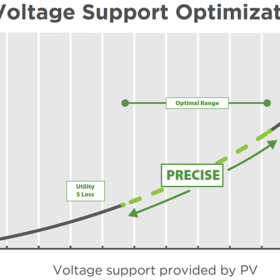
Researchers from the U.S. National Renewable Energy Laboratory have developed a new tool to balance customer curtailment and grid stability. The "Precise" tool for utilities provides unique inverter settings tailored to each customer, with minimal investment and labor for companies that use it.
A research group from the U.S. Department of Energy’s National Renewable Energy Laboratory (NREL) has developed an integrated software tool, known as Precise (PREconfiguring and Controlling Inverter SEt-points), that could help PV system owners to determine optimal inverter settings, while also helping utilities to safely and rapidly incorporate new solar into the grid.
“The tool was ready to use as of March 2019,” NREL’s Group Research Manager, Adarsh Nagarajan, told pv magazine. “We took around two years to develop a fully operational version of Precise. As of now, we are deploying Precise in multiple distribution utilities all around the world.”
The tool manages the amount of customer energy from PV that is curtailed, while considering grid stability issues, such as voltage. “Without Precise, a utility is forced to select settings that are costly to both, as utility costs are ultimately transferred down to the customer,” Nagarajan explained.
Distribution grids
The new tool is expected to fill a gap in the current energy landscape, as traditional distribution networks are simply not designed for customers to generate their own electricity. “Certainly not at the levels currently being seen,” Nagarajan noted. “In the inverter-dense distribution grids that are appearing around the world, customers’ devices are negatively impacting power quality, pushing frequency and voltage into unwanted values.”
The scientists cited the example of Hawaiian Electric, which is currently trying to handle more than 200 MW of rooftop solar generation. As of early 2013, the company started backlogging new PV interconnection requests.
“Power generated by so many rooftop solar systems threaten the safety and reliability of the grid,” it has claimed. The executive director of the Hawaii Solar Energy Association has also referred to Hawaii as a petri dish, stating that “everyone is going to get to this point.”
Dual optimization
Several years ago, NREL offered guidance to the Hawaiian utility on how to coordinate such devices to overcome impacts on power quality. While its suggestions have been successful, they have also shown that solar generation needs to be curtailed to stabilize voltage conditions.
“In other words, to stabilize the grid, the output of customer PV was reduced, along with their energy savings,” Nagarajan explained. “Considering solar PV in the rest of the United States, curtailment for grid stabilization is costing hundreds of millions per year.”
He added that Precise E allows utilities to set curtailment levels to those needed to adequately meet necessary grid support.
“To date, there has never been a software tool that tackles the problem of balancing customer curtailment and grid stability, and there has never been a resource for utilities like Precise,” he said. “It is an end-to-end product that achieves this dual-optimization by modeling distribution networks down to the home, analyzing power flows, and providing unique inverter settings tailored to each customer, all with minimal investment and labor for the utility.”
Most utilities are currently managing their systems conservatively to protect them from over-voltage, or are doing nothing to manage the new hardware.
“In either approach, billions of dollars per year in energy savings and network upgrades are at stake for utilities and customers across the United States,” Nagarajan noted.
Software features
According to the research group, Precise could automate a process that otherwise requires utilities to perform lengthy integration studies. “In simulations of SMUD’s distribution networks, the software cut application times in half, from 10–15 days to five,” Nagarajan said.
The software’s features include the visibility of network topology and the geographic location of solar systems, the ability to perform power-flow analysis, and the choice of advanced inverter modes for analysis, among other functions. It can also assist efforts to follow grid interconnection standards, as well as the adherence to limitations from reactive power limits and the parameterization of weather events and local grid conditions.
“Precise co-optimizes two opposing criteria: grid operation and impacts on customer PV generation,” Nagarajan explained. “It prescribes inverter settings that guarantee stability while balancing the customer’s need for energy savings.”
NREL says the software does not require any control system or communication infrastructure upgrades, and it is ready to use with the latest generation of inverter-based technologies.
“It is a communications-free technology, yet it can take advantage of communications systems if they are available,” Nagarajan concluded. “No requirement for extra communication infrastructure means no additional cybersecurity vulnerabilities, retained customer privacy, and local operation without any top-down utility control.”
Lắp đặt điện mặt trời Khải Minh Tech
https://ift.tt/2X7bF6x
0906633505
info.khaiminhtech@gmail.com
80/39 Trần Quang Diệu, Phường 14, Quận 3
Lắp đặt điện mặt trời Khải Minh Tech
https://ift.tt/2ZH4TRU
Không có nhận xét nào:
Đăng nhận xét